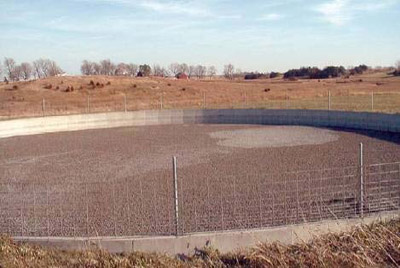Reprinted, with permission, from the proceedings of: Mitigating Air Emissions From Animal Feeding Operations Conference.

This Technology is Applicable To:
Species: Beef, Dairy, Swine
Use Area: Manure Treatment
Technology Category: Covers
Air Mitigated Pollutants: Ammonia, Odors, Hydrogen Sulfide
System Summary
Covers have been demonstrated to provide effective odor and air emissions control for manure storage structures. Impermeable covers made from flexible synthetic materials provide excellent odor and emissions control, but typically have a high capital cost requirement. Permeable covers provide an alternative to impermeable synthetic covers. Permeable covers will typically not provide as great a level of odor control as impermeable covers, but the initial capital cost is lower. Permeable covers do not require gas or rain water collection systems since gases are allowed to migrate through the cover and rainwater will infiltrate through the cover into the storage. Permeable covers have been successfully constructed from a variety of materials including straw, light weight expanded clay aggregate (LECA), ground rubber and geotextile materials. Materials such as straw, have a short lifespan (from two to six months depending on manure solids content and rainfall levels), while materials such as LECA have been shown to remain viable for more than ten years. Various permeable cover materials have been shown to reduce odor from 40% – 90%, and to reduce ammonia from 40% to 80% depending on permeable cover material and depth.
Applicability and Mitigating Mechanism
- Permeable covers provide a layer on the manure surface that shields the manure surface from contact with the air
- Most permeable cover materials provide an aerobic zone in the cover material that will help control odor
- No gas or water collection systems are required since both gases and rain water will pass through the permeable cover material
- Some permeable cover materials such as straw provide a short-term solution, while other like LECA can last more than ten years
Limitations
- Some permeable cover materials (such as straw) have very short effective lives (2 – 6 months)
- Long-term permeable cover materials (such as LECA) can have costs near those of synthetic impermeable covers
- If a permeable cover material sinks into the stored manure, it must be dealt with during land application
- Rainwater volume must be accounted for in the manure storage since direct precipitation will infiltrate into the manure storage
Cost
Permeable covers can provide reductions in odor, ammonia and hydrogen sulfide emissions from manure storage facilities. A wide variety of organic and manmade materials have been utilized to construct permeable covers with variable results and costs ranging from $0.10 to $1.75 per square foot installed. Straw is the least cost permeable cover material with an approximate cost of $0.10 per square foot installed. Longer lasting materials such as LECA have installed costs that can exceed $1.00 per square foot installed. Permeable cover materials are typically floated on the stored manure surface and can provide an aerobic zone that manure gases must pass through when released. Permeable covers can be used with earthen, concrete and steel manure storage systems and with slurry manures generated by swine, dairy and beef animals.
Authors
Robert Burns and Lara Moody, Iowa State University
Point of Contact:
Robert Burns, rburns@iastate.edu
The information provided here was developed for the conference Mitigating Air Emissions From Animal Feeding Operations Conference held in May 2008. To obtain updates, readers are encouraged to contact the author.



